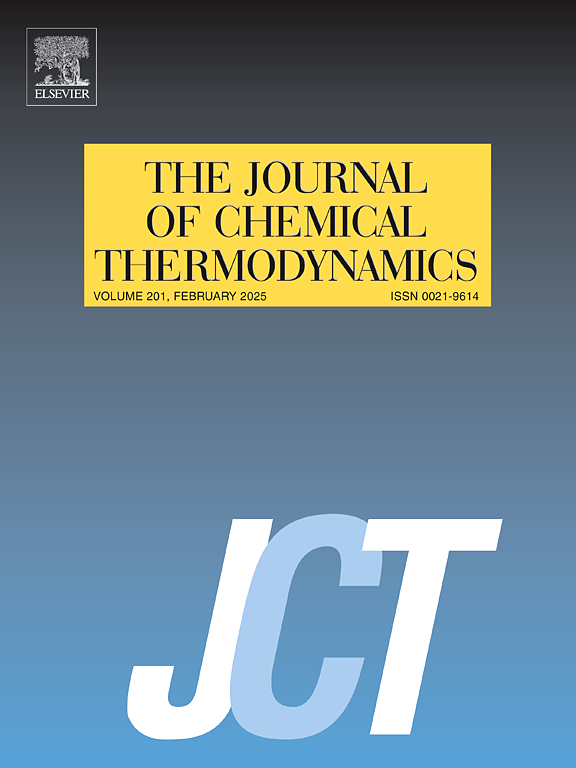甲醇、乙醇和2-丙醇在致密相CO2中的表观摩尔体积
IF 2.2
3区 工程技术
Q3 CHEMISTRY, PHYSICAL
引用次数: 0
摘要
尽管CO2处理和在超临界流体萃取中使用脂肪族醇作为助溶剂的重要性日益增加,但在文献中明显缺乏近临界CO2中稀醇的密度或体积数据。为此,在T = 298-313 K和p = 8-13 MPa的条件下,使用改进的高压测量流量密度计,通过测量密度差(δΔρ = 0.01-1.60 kg m - 3),计算出甲醇、乙醇和2-丙醇在CO2中的二元溶液的表观摩尔体积。选择这个温度和压力范围是为了接近纯二氧化碳的临界点,在那里,体积变化非常敏感,可以更好地校准二进制参数。采用纯组分亥姆霍兹状态方程和涨落解理论,利用混合物的表观摩尔体积来优化混合系数。与波动解理论相比,这些醇溶质的表观摩尔体积导致二元混合系数的拟合较差,参比质量降低了亥姆霍兹状态方程;然而,未来的研究人员可能会开发出具有更多参数的过剩函数。利用波动解理论方程,确定了CO2中每种醇的克里切夫斯基参数。这些数值与之前对CO2中H2O的研究相似;然而,不同外推方法的文献值存在差异。本文章由计算机程序翻译,如有差异,请以英文原文为准。
Apparent molar volumes of methanol, ethanol, and 2-propanol in dense phase CO2
Despite the increasing importance of CO2 processing and the use of aliphatic alcohols as cosolvents in supercritical fluid extraction, there is an apparent lack of densimetric or volumetric data for dilute alcohols in near-critical CO2 within the literature. To this end, apparent molar volumes of binary solutions for methanol, ethanol, and 2-propanol in CO2 were calculated from measured density differences (δΔρ = 0.01–1.60 kg m−3) determined from T = 298–313 K and p = 8–13 MPa using a flow densimeter modified for high pressure measurement. This temperature and pressure range was chosen for the proximity to the critical point of pure CO2, where volumetric changes are very sensitive and allow for better calibration of binary parameters. The apparent molar volumes of the mixtures were then used to optimize mixing coefficients with reference quality pure component Helmholtz equations-of-state and Fluctuation Solution Theory. Apparent molar volumes of these alcohol solutes resulted in poorer fits of the binary mixing coefficients for reference quality reduced Helmholtz Equations of State when compared to Fluctuation Solution Theory; however, excess functions with more parameters may be developed by future researchers. With the Fluctuation Solution Theory equations, Krichevskii parameters were determined for each alcohol in CO2. These values were similar to a previous study of H2O in CO2; however, variance was noted from literature values with different methods of extrapolation.
求助全文
通过发布文献求助,成功后即可免费获取论文全文。
去求助
来源期刊

Journal of Chemical Thermodynamics
工程技术-热力学
CiteScore
5.60
自引率
15.40%
发文量
199
审稿时长
79 days
期刊介绍:
The Journal of Chemical Thermodynamics exists primarily for dissemination of significant new knowledge in experimental equilibrium thermodynamics and transport properties of chemical systems. The defining attributes of The Journal are the quality and relevance of the papers published.
The Journal publishes work relating to gases, liquids, solids, polymers, mixtures, solutions and interfaces. Studies on systems with variability, such as biological or bio-based materials, gas hydrates, among others, will also be considered provided these are well characterized and reproducible where possible. Experimental methods should be described in sufficient detail to allow critical assessment of the accuracy claimed.
Authors are encouraged to provide physical or chemical interpretations of the results. Articles can contain modelling sections providing representations of data or molecular insights into the properties or transformations studied. Theoretical papers on chemical thermodynamics using molecular theory or modelling are also considered.
The Journal welcomes review articles in the field of chemical thermodynamics but prospective authors should first consult one of the Editors concerning the suitability of the proposed review.
Contributions of a routine nature or reporting on uncharacterised materials are not accepted.
 求助内容:
求助内容: 应助结果提醒方式:
应助结果提醒方式:


